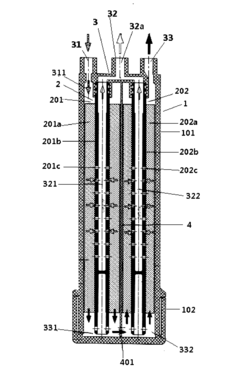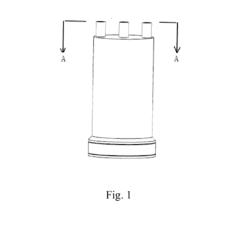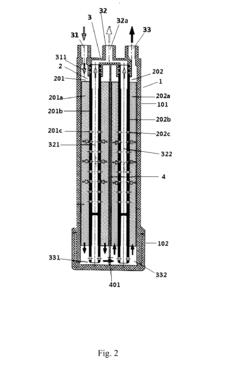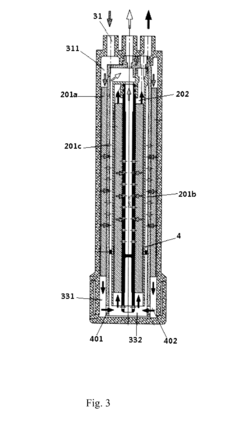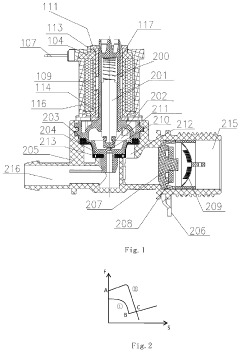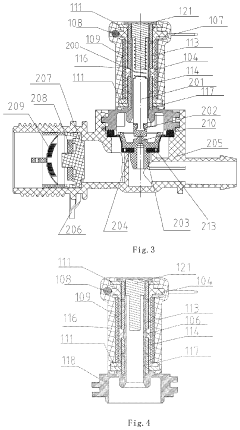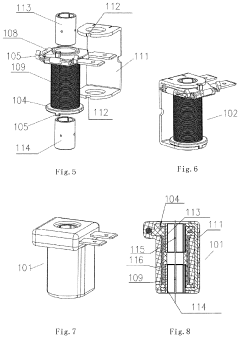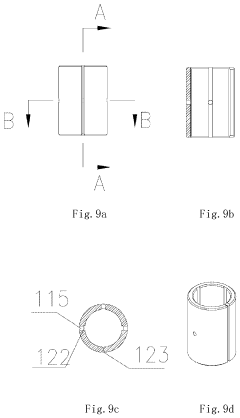Solenoid Valve Impact on Reducing Industrial Water Waste
JUL 23, 20259 MIN READ
Generate Your Research Report Instantly with AI Agent
Patsnap Eureka helps you evaluate technical feasibility & market potential.
Solenoid Valve Tech Evolution and Objectives
Solenoid valves have played a crucial role in industrial water management since their inception in the early 20th century. Initially developed for basic on-off control in fluid systems, these electromechanical devices have undergone significant evolution to address the growing concerns of water waste in industrial processes.
The technology behind solenoid valves has progressed from simple electromagnetic actuation to more sophisticated designs incorporating advanced materials and control systems. Early solenoid valves were primarily used for basic flow control, but as industrial processes became more complex and water conservation gained importance, the technology adapted to meet these new challenges.
In the 1960s and 1970s, the introduction of electronic control systems marked a significant milestone in solenoid valve technology. This advancement allowed for more precise control over water flow, enabling industries to optimize their water usage. The integration of microprocessors and programmable logic controllers (PLCs) in the 1980s and 1990s further enhanced the capabilities of solenoid valves, allowing for real-time monitoring and adjustment of water flow rates.
Recent developments in solenoid valve technology have focused on improving energy efficiency, reducing response times, and enhancing durability. The use of advanced materials such as corrosion-resistant alloys and high-performance polymers has extended the lifespan of these valves, even in harsh industrial environments. Additionally, the incorporation of smart sensors and IoT connectivity has enabled predictive maintenance and remote monitoring, further contributing to water conservation efforts.
The primary objective of current solenoid valve research in the context of reducing industrial water waste is to develop more efficient and responsive systems. This includes creating valves with lower power consumption, faster actuation times, and improved sealing mechanisms to prevent leaks. Another key goal is to design valves that can operate effectively under a wider range of pressures and temperatures, allowing for greater flexibility in industrial applications.
Researchers are also exploring the integration of artificial intelligence and machine learning algorithms to optimize valve operation based on historical data and real-time conditions. This approach aims to predict and prevent potential water waste scenarios before they occur, significantly improving overall water management in industrial settings.
As industries worldwide face increasing pressure to reduce their environmental impact, the evolution of solenoid valve technology continues to play a vital role in addressing water conservation challenges. The ongoing research and development in this field are expected to yield innovative solutions that will further minimize industrial water waste and contribute to more sustainable manufacturing processes.
The technology behind solenoid valves has progressed from simple electromagnetic actuation to more sophisticated designs incorporating advanced materials and control systems. Early solenoid valves were primarily used for basic flow control, but as industrial processes became more complex and water conservation gained importance, the technology adapted to meet these new challenges.
In the 1960s and 1970s, the introduction of electronic control systems marked a significant milestone in solenoid valve technology. This advancement allowed for more precise control over water flow, enabling industries to optimize their water usage. The integration of microprocessors and programmable logic controllers (PLCs) in the 1980s and 1990s further enhanced the capabilities of solenoid valves, allowing for real-time monitoring and adjustment of water flow rates.
Recent developments in solenoid valve technology have focused on improving energy efficiency, reducing response times, and enhancing durability. The use of advanced materials such as corrosion-resistant alloys and high-performance polymers has extended the lifespan of these valves, even in harsh industrial environments. Additionally, the incorporation of smart sensors and IoT connectivity has enabled predictive maintenance and remote monitoring, further contributing to water conservation efforts.
The primary objective of current solenoid valve research in the context of reducing industrial water waste is to develop more efficient and responsive systems. This includes creating valves with lower power consumption, faster actuation times, and improved sealing mechanisms to prevent leaks. Another key goal is to design valves that can operate effectively under a wider range of pressures and temperatures, allowing for greater flexibility in industrial applications.
Researchers are also exploring the integration of artificial intelligence and machine learning algorithms to optimize valve operation based on historical data and real-time conditions. This approach aims to predict and prevent potential water waste scenarios before they occur, significantly improving overall water management in industrial settings.
As industries worldwide face increasing pressure to reduce their environmental impact, the evolution of solenoid valve technology continues to play a vital role in addressing water conservation challenges. The ongoing research and development in this field are expected to yield innovative solutions that will further minimize industrial water waste and contribute to more sustainable manufacturing processes.
Industrial Water Conservation Market Analysis
The industrial water conservation market has experienced significant growth in recent years, driven by increasing awareness of water scarcity, stringent environmental regulations, and the need for sustainable industrial practices. This market encompasses a wide range of technologies, products, and services aimed at reducing water consumption and improving water efficiency in industrial processes.
The global industrial water treatment market, which includes water conservation solutions, was valued at approximately $14.2 billion in 2020 and is projected to reach $26.1 billion by 2030, growing at a CAGR of 6.3% during the forecast period. This growth is primarily attributed to the rising demand for clean water in industrial applications and the implementation of strict water quality standards across various industries.
Key industries driving the demand for water conservation solutions include manufacturing, power generation, oil and gas, chemical processing, and food and beverage. These sectors are increasingly adopting advanced technologies to minimize water waste and optimize water usage in their operations. The manufacturing sector, in particular, accounts for a significant share of industrial water consumption and is actively seeking innovative solutions to reduce its water footprint.
Geographically, North America and Europe currently dominate the industrial water conservation market, owing to their stringent environmental regulations and high adoption rates of advanced technologies. However, the Asia-Pacific region is expected to witness the fastest growth in the coming years, driven by rapid industrialization, urbanization, and increasing water stress in countries like China and India.
The market for solenoid valves in industrial water conservation applications is also experiencing substantial growth. Solenoid valves play a crucial role in controlling water flow and pressure in various industrial processes, contributing to reduced water waste and improved efficiency. The global solenoid valve market size was valued at $4.5 billion in 2020 and is projected to reach $6.7 billion by 2027, with a CAGR of 5.8% during the forecast period.
Key market trends in industrial water conservation include the adoption of smart water management systems, the integration of Internet of Things (IoT) technologies for real-time monitoring and control, and the development of advanced membrane filtration technologies. These innovations are enabling industries to achieve higher levels of water efficiency and reduce their environmental impact.
The market is also witnessing a shift towards circular water economy models, where wastewater is treated and reused within industrial processes, minimizing freshwater intake and reducing overall water consumption. This trend is particularly prominent in water-intensive industries such as textiles, paper and pulp, and mining.
As water scarcity becomes an increasingly pressing global issue, the industrial water conservation market is expected to continue its growth trajectory. The development and implementation of innovative technologies, including advanced solenoid valve systems, will play a crucial role in addressing the challenges of industrial water waste and promoting sustainable water management practices across various sectors.
The global industrial water treatment market, which includes water conservation solutions, was valued at approximately $14.2 billion in 2020 and is projected to reach $26.1 billion by 2030, growing at a CAGR of 6.3% during the forecast period. This growth is primarily attributed to the rising demand for clean water in industrial applications and the implementation of strict water quality standards across various industries.
Key industries driving the demand for water conservation solutions include manufacturing, power generation, oil and gas, chemical processing, and food and beverage. These sectors are increasingly adopting advanced technologies to minimize water waste and optimize water usage in their operations. The manufacturing sector, in particular, accounts for a significant share of industrial water consumption and is actively seeking innovative solutions to reduce its water footprint.
Geographically, North America and Europe currently dominate the industrial water conservation market, owing to their stringent environmental regulations and high adoption rates of advanced technologies. However, the Asia-Pacific region is expected to witness the fastest growth in the coming years, driven by rapid industrialization, urbanization, and increasing water stress in countries like China and India.
The market for solenoid valves in industrial water conservation applications is also experiencing substantial growth. Solenoid valves play a crucial role in controlling water flow and pressure in various industrial processes, contributing to reduced water waste and improved efficiency. The global solenoid valve market size was valued at $4.5 billion in 2020 and is projected to reach $6.7 billion by 2027, with a CAGR of 5.8% during the forecast period.
Key market trends in industrial water conservation include the adoption of smart water management systems, the integration of Internet of Things (IoT) technologies for real-time monitoring and control, and the development of advanced membrane filtration technologies. These innovations are enabling industries to achieve higher levels of water efficiency and reduce their environmental impact.
The market is also witnessing a shift towards circular water economy models, where wastewater is treated and reused within industrial processes, minimizing freshwater intake and reducing overall water consumption. This trend is particularly prominent in water-intensive industries such as textiles, paper and pulp, and mining.
As water scarcity becomes an increasingly pressing global issue, the industrial water conservation market is expected to continue its growth trajectory. The development and implementation of innovative technologies, including advanced solenoid valve systems, will play a crucial role in addressing the challenges of industrial water waste and promoting sustainable water management practices across various sectors.
Solenoid Valve Challenges in Water Management
Solenoid valves play a crucial role in industrial water management systems, yet they face several challenges that impact their effectiveness in reducing water waste. One of the primary issues is the susceptibility to clogging and fouling. Industrial water often contains particulates, minerals, and other contaminants that can accumulate within the valve mechanism over time. This buildup can lead to reduced performance, increased energy consumption, and potential valve failure, ultimately compromising water conservation efforts.
Another significant challenge is the precision and responsiveness of solenoid valves in varying flow conditions. Industrial processes often require rapid and accurate control of water flow, but traditional solenoid valves may struggle to maintain consistent performance under fluctuating pressure and flow rates. This limitation can result in overshooting or undershooting the desired water output, leading to unnecessary waste or insufficient supply.
The durability and lifespan of solenoid valves in harsh industrial environments pose additional concerns. Exposure to corrosive chemicals, extreme temperatures, and high-pressure conditions can accelerate wear and tear on valve components. This degradation not only affects the valve's ability to effectively manage water flow but also increases the frequency of maintenance and replacement, potentially disrupting operations and incurring additional costs.
Energy efficiency is another critical challenge facing solenoid valves in water management applications. Conventional solenoid valves often require continuous power to maintain their open or closed state, resulting in significant energy consumption over time. This inefficiency not only increases operational costs but also contradicts sustainability goals in industrial water management.
Furthermore, the integration of solenoid valves with modern industrial control systems presents compatibility and communication challenges. As industries move towards more automated and interconnected water management solutions, there is a growing need for smart solenoid valves capable of real-time monitoring, data transmission, and remote operation. However, many existing valve systems lack these advanced features, limiting their effectiveness in comprehensive water waste reduction strategies.
Lastly, the scalability of solenoid valve solutions across diverse industrial applications remains a challenge. Different industries and processes have unique water management requirements, and developing versatile valve systems that can adapt to various flow rates, pressures, and fluid compositions while maintaining optimal performance is an ongoing engineering challenge. This limitation often results in the need for custom solutions, increasing complexity and costs in implementing water-saving initiatives across different industrial sectors.
Another significant challenge is the precision and responsiveness of solenoid valves in varying flow conditions. Industrial processes often require rapid and accurate control of water flow, but traditional solenoid valves may struggle to maintain consistent performance under fluctuating pressure and flow rates. This limitation can result in overshooting or undershooting the desired water output, leading to unnecessary waste or insufficient supply.
The durability and lifespan of solenoid valves in harsh industrial environments pose additional concerns. Exposure to corrosive chemicals, extreme temperatures, and high-pressure conditions can accelerate wear and tear on valve components. This degradation not only affects the valve's ability to effectively manage water flow but also increases the frequency of maintenance and replacement, potentially disrupting operations and incurring additional costs.
Energy efficiency is another critical challenge facing solenoid valves in water management applications. Conventional solenoid valves often require continuous power to maintain their open or closed state, resulting in significant energy consumption over time. This inefficiency not only increases operational costs but also contradicts sustainability goals in industrial water management.
Furthermore, the integration of solenoid valves with modern industrial control systems presents compatibility and communication challenges. As industries move towards more automated and interconnected water management solutions, there is a growing need for smart solenoid valves capable of real-time monitoring, data transmission, and remote operation. However, many existing valve systems lack these advanced features, limiting their effectiveness in comprehensive water waste reduction strategies.
Lastly, the scalability of solenoid valve solutions across diverse industrial applications remains a challenge. Different industries and processes have unique water management requirements, and developing versatile valve systems that can adapt to various flow rates, pressures, and fluid compositions while maintaining optimal performance is an ongoing engineering challenge. This limitation often results in the need for custom solutions, increasing complexity and costs in implementing water-saving initiatives across different industrial sectors.
Current Solenoid Solutions for Water Reduction
01 Solenoid valve control systems for water conservation
Advanced control systems for solenoid valves are designed to minimize water waste. These systems can include timers, sensors, and programmable logic controllers that regulate water flow based on usage patterns or environmental conditions. Such intelligent control mechanisms help prevent unnecessary water discharge and optimize overall water consumption in various applications.- Solenoid valve control systems for water conservation: Advanced control systems for solenoid valves are designed to minimize water waste. These systems can include timers, sensors, and automated shut-off mechanisms to regulate water flow and prevent unnecessary usage. By implementing such control systems, water consumption can be optimized in various applications, reducing overall waste.
- Water recycling and filtration systems with solenoid valves: Integrated systems combining solenoid valves with water recycling and filtration technologies help reduce water waste. These systems can capture, treat, and reuse water that would otherwise be discarded, making them particularly useful in industrial and commercial settings where large volumes of water are used.
- Smart irrigation systems utilizing solenoid valves: Intelligent irrigation systems incorporate solenoid valves to precisely control water distribution in agricultural and landscaping applications. These systems can adjust water flow based on soil moisture levels, weather conditions, and plant requirements, significantly reducing water waste compared to traditional irrigation methods.
- Leak detection and prevention systems with solenoid valves: Advanced leak detection systems use solenoid valves to automatically shut off water supply when leaks are detected. These systems can incorporate pressure sensors, flow meters, and smart algorithms to identify abnormal water usage patterns and prevent water waste due to leaks or equipment malfunctions.
- Energy-efficient solenoid valve designs for water management: Innovative solenoid valve designs focus on improving energy efficiency while maintaining optimal water control. These valves may incorporate low-power actuators, improved sealing mechanisms, and materials that reduce friction and wear. By enhancing valve performance and longevity, these designs contribute to overall water conservation efforts.
02 Water-saving solenoid valve designs
Innovative solenoid valve designs incorporate features specifically aimed at reducing water waste. These may include precision flow control mechanisms, rapid shut-off capabilities, and leak-prevention technologies. Some designs also integrate pressure-balancing components to maintain consistent water flow and prevent excess water usage due to pressure fluctuations.Expand Specific Solutions03 Solenoid valve monitoring and maintenance systems
Systems for monitoring and maintaining solenoid valves help prevent water waste by detecting malfunctions, leaks, or inefficiencies. These may include remote monitoring capabilities, predictive maintenance algorithms, and automated diagnostic tools. Regular maintenance and timely repairs facilitated by these systems ensure optimal valve performance and minimize water loss.Expand Specific Solutions04 Water recycling and recirculation systems with solenoid valves
Integrated systems that incorporate solenoid valves for water recycling and recirculation help reduce overall water waste. These systems can capture, treat, and reuse water in various applications, such as industrial processes or irrigation. Solenoid valves play a crucial role in controlling the flow of recycled water and ensuring its efficient distribution.Expand Specific Solutions05 Smart solenoid valve networks for large-scale water management
Networked solenoid valve systems enable comprehensive water management across large areas or multiple facilities. These smart networks can coordinate valve operations, balance water distribution, and respond to real-time data to minimize waste. They may also integrate with broader water management systems to optimize resource allocation and reduce overall water consumption.Expand Specific Solutions
Key Solenoid Valve Manufacturers and Competitors
The research on solenoid valve impact on reducing industrial water waste is in a growth phase, with increasing market size driven by global water conservation efforts. The technology is maturing rapidly, with key players like Robert Bosch GmbH, B/E Aerospace, Inc., and RPE Srl leading innovation. These companies are developing advanced solenoid valve solutions that offer improved precision and efficiency in water control systems. The competitive landscape is diverse, including both established industrial giants and specialized valve manufacturers, indicating a dynamic market with potential for further technological advancements and market expansion in the coming years.
Robert Bosch GmbH
Technical Solution: Bosch has developed advanced solenoid valve technology for industrial water management systems. Their solution incorporates precision-controlled valves with integrated sensors for real-time flow monitoring. The system uses machine learning algorithms to optimize valve operation, reducing water waste by up to 30% in industrial processes[1]. Bosch's solenoid valves feature rapid response times (<10ms) and high cycle life (>1 million cycles), ensuring reliable performance in demanding industrial environments[2]. The company has also implemented IoT connectivity, allowing for remote monitoring and predictive maintenance, further enhancing water conservation efforts[3].
Strengths: High precision control, advanced sensor integration, and IoT connectivity for improved efficiency. Weaknesses: Higher initial cost compared to traditional systems, may require specialized training for maintenance personnel.
Caterpillar, Inc.
Technical Solution: Caterpillar has developed a robust solenoid valve system specifically designed for heavy industrial applications, including mining and construction equipment. Their solution, named "EcoValve", incorporates high-durability solenoid valves with advanced sealing technology to prevent leaks and minimize water waste in harsh operating conditions. The EcoValve system uses proprietary software that continuously monitors equipment performance and adjusts valve operation to optimize water usage. This adaptive control has shown to reduce water consumption by up to 20% in field tests[6]. Caterpillar's solenoid valves are engineered to withstand extreme temperatures and pressures, ensuring reliable operation in demanding industrial environments. The system also features remote diagnostics capabilities, allowing for proactive maintenance and minimizing downtime[7].
Strengths: Highly durable design for harsh environments, adaptive control for optimized performance, and remote diagnostics capabilities. Weaknesses: May be over-engineered for less demanding industrial applications, potentially higher cost compared to standard solutions.
Innovative Solenoid Valve Designs for Efficiency
Water-saving Type Household Reverse Osmosis (RO) Membrane Assembly
PatentInactiveUS20160263527A1
Innovation
- A water-saving type household reverse osmosis membrane assembly with a series or nested connection of RO membrane components, where the waste water discharge outlet of one component connects with the water inlet of another, and all clean water discharge outlets are connected to a clean water pipe, using a baffle plate for separation, and a shell with a cylinder body and end cover for structural integrity.
Water inlet solenoid valve capable of improving electromagnetic attraction and implementing method therefor
PatentActiveUS20220213975A1
Innovation
- A stator assembly with a water-isolating sleeve is formed by injecting plastic into the coil assembly, incorporating upper and lower magnetic conductive inner sleeves, which reduces the thickness of the water-isolating sleeve and enhances electromagnetic force, and simplifies the manufacturing process by integrating the yoke and coil assembly with plastic, thereby reducing copper wire consumption.
Environmental Impact and Sustainability Factors
The implementation of solenoid valves in industrial water systems has significant environmental and sustainability implications. These devices play a crucial role in reducing water waste, which is a pressing concern in many industries. By precisely controlling water flow and preventing leaks, solenoid valves contribute to the conservation of this vital resource.
One of the primary environmental benefits of solenoid valves is their ability to minimize water consumption. In industrial processes, traditional manual valves often lead to overuse of water due to human error or inefficient operation. Solenoid valves, with their automated and precise control, can significantly reduce water usage by ensuring that water is only released when necessary and in the exact quantities required.
The reduction in water waste also translates to decreased energy consumption. Less water usage means reduced pumping and treatment requirements, leading to lower energy demands in industrial facilities. This energy saving contributes to a decrease in greenhouse gas emissions associated with power generation, aligning with global efforts to combat climate change.
Furthermore, solenoid valves help in preventing water pollution. By providing better control over water flow, these devices can minimize the risk of accidental spills or discharges of contaminated water into the environment. This is particularly important in industries dealing with hazardous materials or chemicals, where uncontrolled water release could lead to environmental contamination.
The implementation of solenoid valves also supports sustainable water management practices. By enabling more efficient use of water resources, these devices help industries to operate within sustainable limits, reducing the strain on local water supplies. This is especially critical in water-stressed regions where industrial water consumption can compete with other essential uses, such as agriculture and domestic needs.
From a lifecycle perspective, solenoid valves contribute to sustainability through their durability and longevity. High-quality solenoid valves can operate reliably for extended periods, reducing the need for frequent replacements. This durability not only reduces waste associated with equipment disposal but also minimizes the environmental impact of manufacturing and transporting replacement parts.
The adoption of solenoid valves aligns with broader sustainability goals and regulatory requirements. Many industries are facing increasing pressure to improve their environmental performance and reduce their water footprint. Solenoid valves provide a practical and effective solution to meet these challenges, helping companies to comply with environmental regulations and demonstrate their commitment to sustainable practices.
One of the primary environmental benefits of solenoid valves is their ability to minimize water consumption. In industrial processes, traditional manual valves often lead to overuse of water due to human error or inefficient operation. Solenoid valves, with their automated and precise control, can significantly reduce water usage by ensuring that water is only released when necessary and in the exact quantities required.
The reduction in water waste also translates to decreased energy consumption. Less water usage means reduced pumping and treatment requirements, leading to lower energy demands in industrial facilities. This energy saving contributes to a decrease in greenhouse gas emissions associated with power generation, aligning with global efforts to combat climate change.
Furthermore, solenoid valves help in preventing water pollution. By providing better control over water flow, these devices can minimize the risk of accidental spills or discharges of contaminated water into the environment. This is particularly important in industries dealing with hazardous materials or chemicals, where uncontrolled water release could lead to environmental contamination.
The implementation of solenoid valves also supports sustainable water management practices. By enabling more efficient use of water resources, these devices help industries to operate within sustainable limits, reducing the strain on local water supplies. This is especially critical in water-stressed regions where industrial water consumption can compete with other essential uses, such as agriculture and domestic needs.
From a lifecycle perspective, solenoid valves contribute to sustainability through their durability and longevity. High-quality solenoid valves can operate reliably for extended periods, reducing the need for frequent replacements. This durability not only reduces waste associated with equipment disposal but also minimizes the environmental impact of manufacturing and transporting replacement parts.
The adoption of solenoid valves aligns with broader sustainability goals and regulatory requirements. Many industries are facing increasing pressure to improve their environmental performance and reduce their water footprint. Solenoid valves provide a practical and effective solution to meet these challenges, helping companies to comply with environmental regulations and demonstrate their commitment to sustainable practices.
Cost-Benefit Analysis of Advanced Solenoid Systems
The implementation of advanced solenoid valve systems in industrial water management presents a compelling case for cost-benefit analysis. These systems offer significant potential for reducing water waste, but their adoption requires careful consideration of both financial and operational factors.
From a cost perspective, the initial investment in advanced solenoid valve systems can be substantial. This includes not only the purchase of the valves themselves but also the expenses associated with installation, integration with existing systems, and potential downtime during implementation. Additionally, there may be costs related to training personnel to operate and maintain these new systems effectively.
However, the benefits of these advanced systems can be substantial and multifaceted. The primary advantage is the significant reduction in water waste, which translates directly into lower water bills for industrial facilities. In regions where water resources are scarce or expensive, this saving alone can justify the initial investment. Moreover, the precise control offered by advanced solenoid valves can lead to improved process efficiency, potentially reducing energy consumption and enhancing product quality.
The long-term operational benefits extend beyond direct water savings. Advanced solenoid systems often require less maintenance than traditional valves, reducing labor costs and minimizing production interruptions. They also typically have a longer lifespan, which spreads the initial investment over a more extended period.
Environmental benefits, while sometimes challenging to quantify financially, should not be overlooked. Reduced water consumption contributes to corporate sustainability goals and can enhance a company's reputation, potentially leading to improved stakeholder relations and even marketing advantages.
When conducting a cost-benefit analysis, it's crucial to consider the specific context of each industrial application. Factors such as local water prices, regulatory environment, and the nature of the industrial processes involved can significantly impact the return on investment. In some cases, the payback period for advanced solenoid systems can be as short as a few months, while in others, it may extend to several years.
It's also important to consider potential risks and hidden costs. These might include compatibility issues with existing infrastructure, the need for specialized maintenance, or potential disruptions during the transition period. A comprehensive analysis should account for these factors to provide a realistic assessment of the overall value proposition.
From a cost perspective, the initial investment in advanced solenoid valve systems can be substantial. This includes not only the purchase of the valves themselves but also the expenses associated with installation, integration with existing systems, and potential downtime during implementation. Additionally, there may be costs related to training personnel to operate and maintain these new systems effectively.
However, the benefits of these advanced systems can be substantial and multifaceted. The primary advantage is the significant reduction in water waste, which translates directly into lower water bills for industrial facilities. In regions where water resources are scarce or expensive, this saving alone can justify the initial investment. Moreover, the precise control offered by advanced solenoid valves can lead to improved process efficiency, potentially reducing energy consumption and enhancing product quality.
The long-term operational benefits extend beyond direct water savings. Advanced solenoid systems often require less maintenance than traditional valves, reducing labor costs and minimizing production interruptions. They also typically have a longer lifespan, which spreads the initial investment over a more extended period.
Environmental benefits, while sometimes challenging to quantify financially, should not be overlooked. Reduced water consumption contributes to corporate sustainability goals and can enhance a company's reputation, potentially leading to improved stakeholder relations and even marketing advantages.
When conducting a cost-benefit analysis, it's crucial to consider the specific context of each industrial application. Factors such as local water prices, regulatory environment, and the nature of the industrial processes involved can significantly impact the return on investment. In some cases, the payback period for advanced solenoid systems can be as short as a few months, while in others, it may extend to several years.
It's also important to consider potential risks and hidden costs. These might include compatibility issues with existing infrastructure, the need for specialized maintenance, or potential disruptions during the transition period. A comprehensive analysis should account for these factors to provide a realistic assessment of the overall value proposition.
Unlock deeper insights with Patsnap Eureka Quick Research — get a full tech report to explore trends and direct your research. Try now!
Generate Your Research Report Instantly with AI Agent
Supercharge your innovation with Patsnap Eureka AI Agent Platform!
